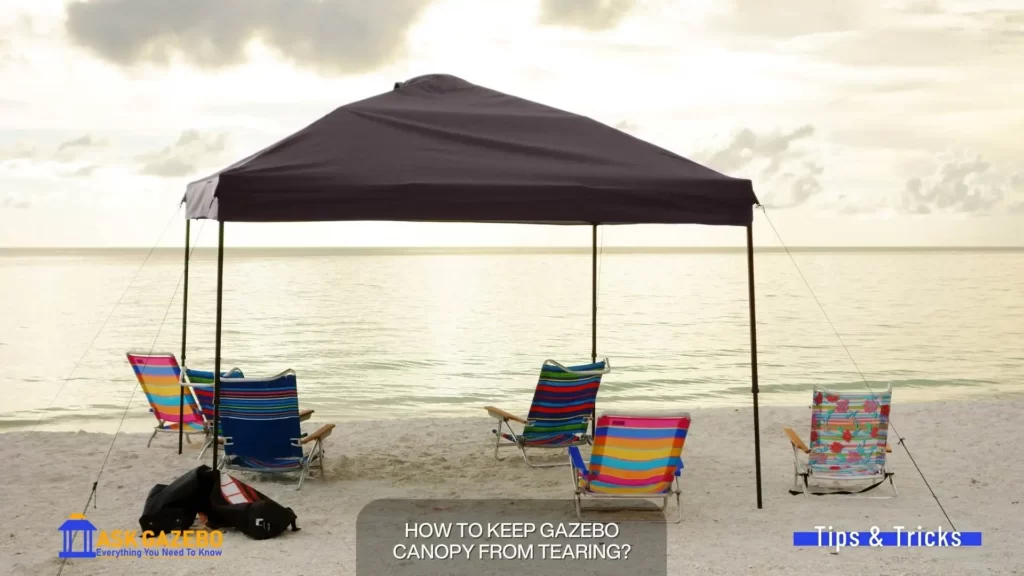Every year, countless gazebo owners experience unexpected wear and tear of the canopy due to negligence or some other reason.
Watching your beautiful gazebo turn into an eyesore is frustrating, especially when you have invested a lot of time, effort, and money into setting it up.
But what if we tell you there is a way you can prevent this issue? What if you could enjoy the canopy’s shelter, protection, and beauty for years to come?
In this article, we have explained tried and tested methods to ensure your gazebo canopy retains its tear-free form for several years and you enjoy the gazebo without worrying about damage.
Factors that contribute to canopy tears
Factors like the quality of the canopy, weather conditions, use cases, assembly technique, and extensive use play a significant role in tearing up a gazebo canopy.
Let’s discuss these factors further.
Quality of the canopy material
Canopies are available in various materials that significantly influence their lifespan and durability.
Thin, low-quality canopy fabrics are prone to tears and last from 6 to 12 months. Comparatively, canopies made from heavy-duty materials, including polyester, acrylic, and vinyl, last from 5 to 10 years, as they are more tolerant of environmental stressors.
Weather conditions
Extreme weather conditions like heavy rain, wind, and sun exposure deteriorate canopy material, leading to unwanted wear and tear.
Strong winds exert immense pressure on the fabric, making it flip vigorously. Also, the constant sunrise can weaken and fade the canopy over time. All this weakens the fabric over time and eventually makes it rip.
Similarly, constant exposure to rain increases the risk of mold and mildew growth, further weakening the fabric.
Poor assembly and maintenance
Improper installation of a canopy can make it either too loose or tight. Both conditions produce unique negative effects, making the canopy prone to damage.
Similarly, failing to clean the canopy from time to time could lead to the accumulation of dirt, debris, and pollutants on its surface.
Extensive usage
Frequently setting up and disassembling a gazebo can stress the canopy, especially at the attachment points. Some people hang decorative items like lamps and potted plants on a roof, which strain the fabric and lead to tears.
To avoid damage, handle the gazebo properly and avoid hanging heavy items on the roof.


Effective Ways to Keep Gazebo Canopy From Tearing
From choosing weather-resistant materials to mastering the art of proper maintenance, we’ve got you covered on How To Keep Gazebo Canopy From Tearing. Let’s learn it further.
Protection against weather
The best defense against canopy tearing is using high-quality, weather-resistant materials that can withstand rain, wind, and sun exposure.
Ensure your canopy has reinforced stitching, and water and UV-resistant coatings. Polyester, polyethylene, and vinyl are some durable examples you must consider while purchasing a gazebo canopy.
Proper maintenance
Dirt and pollutants can weaken a canopy’s material over time. Hence, you should regularly maintain it through proper cleaning.
Wash the canopy with a mild detergent, water, and soft brush. Avoid abrasive scrubbing as it can damage the fabric. Dry it completely before storing it to avoid mold and mildew growth.
Optimal placement
Follow the manufacturer’s manual while setting up a gazebo, and ensure the ground underneath is level.
If possible, select a sheltered area away from direct exposure to damaging sun rays, harsh winds, and heavy rainfall. Natural windbreaks like trees, walls, and hedges can provide an additional protective layer.
Protection from UV radiation
If UV radiation is a significant concern in your area, choose canopy materials with high UV protection ratings, as they are specifically designed to withstand prolonged exposure to sunlight.
And if your canopy is not UV-resistant, consider applying a UV-resistant spray that blocks UV ray penetration. You can protect your canopy from weather damage and maintain its appearance by using outdoor curtains and sunshades.
Keep nearby branches trimmed
Canopies installed near trees or shrubs have a high risk of tearing as overhanging branches can puncture or scrape against the fabric. Therefore, you should regularly trim and prune the nearby branches back to a safe distance.
Installing netting during months of extreme foliage growth can help you create a protective barrier.
Fasten it on the gazebo frame the right way
Installing a canopy properly is essential not only for its appearance but also for its stability. Improper fastening can result in sagging and flapping during windy conditions.
Adhere to the manufacturer’s guidelines to make sure you use the correct method, tools, and fasteners to assemble a canopy. Once installed, ensure it is tensioned evenly; otherwise, it could rip anytime.
Regular inspection
Become proactive and identify potential canopy issues before they escalate. Start by creating an inspection schedule, ideally at the start and end of each season.
Thoroughly examine the entire canopy and pay close attention to areas prone to damage, such as corners and stress points.
Note down the identified issues and prioritize them based on their severity. Address urgent problems promptly without further delays.
Proper storage and transportation
If you are storing the canopy for a long time, ensure you do it correctly. Follow these steps to safely store and transport your canopy.
- Clean it thoroughly to ensure it has no debris that could deteriorate the material if left on it for long.
- Dry it thoroughly to prevent fungus growth.
- Choose an airy, dry storage area that is not exposed to direct sunlight. Fold it neatly to save space. Use pest repellents if the risk of pest-causing damage is high.
- When transporting the canopy, place it in a secured area where it won’t flap or rub against sharp objects. It’s safer to put it inside a storage bag or container.
- Avoid stacking heavy objects on top of it to prevent creases and damage.
Repair small damages immediately
Timely intervention can help you handle an issue before it gets worse and leads to a costly repair. Get a canopy repair kit with all the essential tools to fix small tears or punctures. Apply suitable patches following the instructions provided in the kit.
Use additional support structures when necessary
In certain situations, you may need additional support structures like leg weights, anchors, or gazebo weights to ensure the stability of the canopy.
Choose a support structure that best suits your needs. Read the manufacturer’s instructions to securely fasten them when needed.
Remove these structures when the weather is calm, as keeping them on could cause unnecessary wear and tear.


Subscribe For More Gazebo Videos!
Ask Gazebo
What to do if your canopy has already torn?
Sometimes, canopy wear and tear become inevitable, and accidents happen even after taking necessary preventive measures. If that happens to you, here is how to repair a canopy cover.
- Identify the damage: Start by examining the canopy and identifying potential damages. Typical canopy issues include loose seams, tears, and punctures.
- Get a canopy repair kit: Buy a repair kit containing all the essential tools like adhesive tapes, fabric glue, heavy-duty thread, and needles.
- Use adhesive-backed patches: You can repair small tears and punctures using patches that adhere to the canopy fabric. Clean the area, apply the patch, and press it firmly to ensure a tight bond.
- Repair loose seams: Use fabric glue or weather-resistant threads and a needle to address loose seams. Apply a thin glue coating on the loose seam and put pressure on it. If you are using thread, sew the seam back together, ensuring an even and secure stitch.
- Apply clear adhesive tapes: Adhesive tapes provide a temporary solution for minor tears. They can buy you time until you repair the problem using a secure technique.
Signs That Show Canopy Replacement is Necessary:
In some situations, replacing the canopy to maintain its functionality and aesthetics becomes necessary. Here is when you should consider canopy replacement:
- The fabric has been extensively damaged and cannot be properly repaired.
- Color has significantly faded due to exposure to sunlight.
- The material has become stiff due to advanced age.
- The fabric has lost its tension, resulting in sagging and flapping.
- Waterproofing has deteriorated beyond repair, and the canopy leaks during rain.
FAQs
Can you wash a canopy cover in the washing machine?
That depends on the canopy type you have. You should check the instructions written on the tag of your canopy. If there is nothing written on the label, check the manufacturer’s guidelines.
Generally speaking, washing canopies in machines may not be suitable in most cases, as the machine’s agitation can be too harsh on the material.
When to seek professional canopy repair services?
In certain cases, it becomes essential to seek professional help. This is particularly true when one lacks the necessary skills to repair the damage, or when the essential tools are not available.
Additionally, if the damage involves extensive tears or large holes, it is best to consult with a professional who can handle the repair effectively.
Furthermore, if the canopy requires a complicated structural repair, it is best to seek the assistance of a professional who has the necessary expertise.
Finally, if one does not have the time and wants a hassle-free solution, seeking professional help is the best way to go.
How to waterproof a gazebo canopy?
Clean the canopy thoroughly to remove dirt and bird droppings. Leave it to dry completely.
Apply waterproofing spray according to the instructions written on it. Start from one end and work your way to the other. Allow it to dry fully before you install the canopy to the gazebo frame. Drying may take a few hours to a day.
How do you extend the life of a canopy?
To extend the life of your canopy, protect it from harsh weather, apply a waterproof coating, check its condition regularly, assemble and dissemble correctly, and repair every minor damage as soon as possible.
Conclusion
The lifespan and performance of a gazebo canopy depend on how you maintain it. Whether you are enjoying your afternoons in its shade or having small family gatherings outdoors, a tear-free canopy is the key to creating long-lasting memories.
Follow the proven strategies explained above to ensure your canopy stays functional and visually appealing for years to come!







